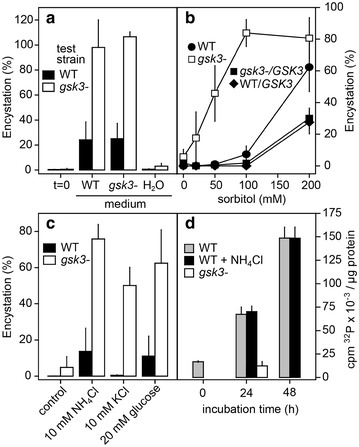Fig. 5.

Effects of secreted factors and osmolytes on encystation and GSK3 activity. a Secreted factors. Wild-type and gsk3− cells were grown to stationary phase with autoclaved K.aerogenes, and medium and cells were separated by centrifugation. The cells were subsequently incubated for 60 h in either water, wild-type medium or gsk3− medium, and cyst percentages were determined after staining with Calcofluor. Means and SE of 4 experiments are presented. b Sorbitol. Wild-type, gsk3−, gsk3−/GSK3 and wild-type/GSK3 cells were incubated with the indicated concentrations of the osmolyte sorbitol. After 48 h of incubation, cells were stained with Calcofluor and percentages of fluorescent cysts were determined. Means and SE of 3 experiments. c Osmolyte sensitivity. Wild-type and gsk3− cells were incubated in 10 mM NH4Cl, 10 mM KCl or 20 mM glucose for 48 h. After Calcofluor staining, the percentage of fluorescent cysts was determined. Means and SE of 4 experiments. d GSK3 activity. Wild-type cells were incubated with and without 10 mM NH4Cl and gsk3− cells without NH4Cl only. Cell extracts were prepared at the indicated time points and incubated with [γ-32P]ATP and the GSK3 substrate phosphoglycogen synthase peptide-2 in the presence and absence of the GSK3 inhibitor LiCl. After 8 min, 32P incorporation in the peptide was measured and non-specific 32P incorporation in the presence of LiCl was subtracted [17]. Means and SE of 4 experiments are presented
